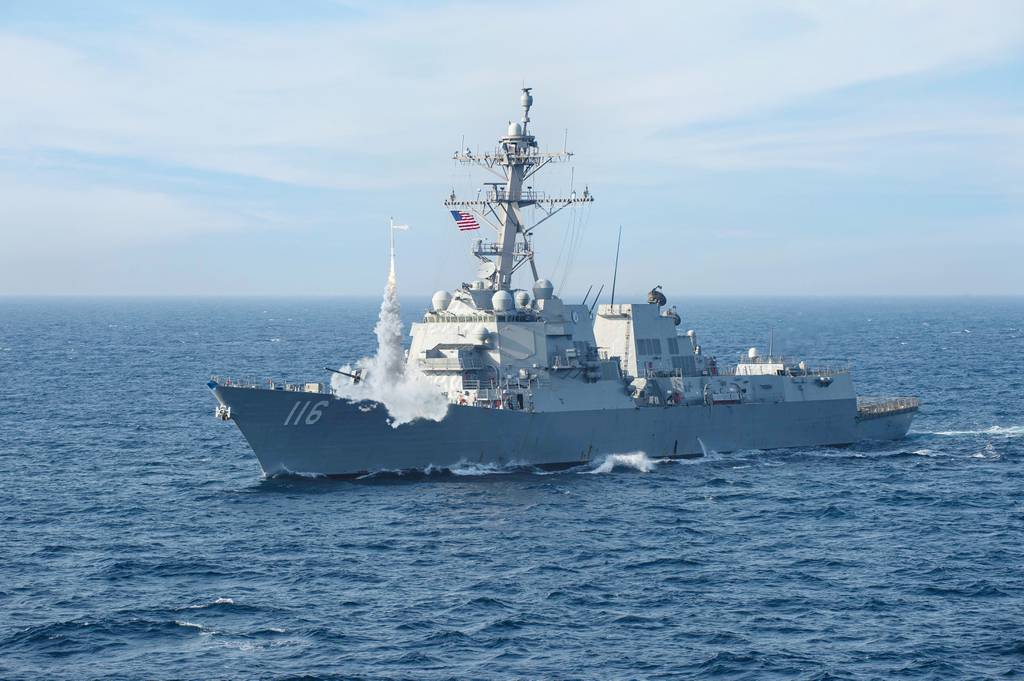WASHINGTON — Lockheed Martin will test this spring whether it can successfully integrate the U.S. Army’s latest and most capable variant of the Patriot missile with the U.S. Navy’s Aegis Combat System.
By the end of the year, Lockheed will have spent roughly $100 million on the Patriot Advanced Capability-3 Missile Segment Enhancement (PAC-3 MSE) integration effort so far, according to Tom Copeman, vice president of naval systems within the company’s missiles and fire control business.
“The U.S. Navy has capability and capacity gaps against advanced threats at sea,” Copeman told Defense News in a Jan. 18 interview. The Patriot missile is “a combat-proven weapon against advanced threats, against hypersonic [weapons].”
The capability is “definitely complementary to what [the Navy has] today,” Shireen Melvin, director of integrated combat management within the company’s rotary and mission systems business, said in the same interview.
Lockheed in 2017 decided to pursue an upgraded capability that would allow it to avoid a typically lengthy and costly missile development schedule, Copeman said.
The PAC-3 MSE, as the upgraded missile is known, already has a hot production line in Camden, Arkansas, that is currently ramping up to produce 550 missiles a year. The missile is typically fired from the U.S. Army’s Patriot air-and-missile defense system. Lockheed has plans to increase its production numbers as it replenishes the stockpile of missiles sent to Ukraine since Russia invaded nearly two years ago.
The Missile Defense Agency provided the company with a small amount of funding early on to integrate PAC-3 MSE into its Aegis Ashore baseline capability. Aegis Ashore provides missile defense capability from a deckhouse on land. There is one operational Aegis Ashore in Romania and another in Poland that has yet to reach full operational capability.
That effort did not include a live-fire test, but rather a hardware-in-the-loop test in the fall of 2022 using Army launchers instead of Navy platforms at the Pacific Missile Range Facility.
Lockheed then invested internally to integrate PAC-3 MSE to be fired from Aegis ships.
In summer 2023, Lockheed proved it could integrate PAC-3 MSE missiles with the Aegis SPY-1 radar, an integrated air-and-missile defense sensor, aboard Aegis capable ships. There are nearly 100 SPY-1 radars aboard Aegis cruisers and destroyers.
The spring live-fire test will use a ground-launched vertical launch system rather than one on board Aegis ships, but is meant to demonstrate integration with the entire Aegis combat system, according to Copeman.
If the test is successful, he added, the company hopes the Navy or Defense Department will conduct further tests that could lead to an initial operational capability on a ship. “As of yet, that has not been funded by the DoD,” Copeman said.
Lockheed has also been involved in efforts with the Missile Defense Agency in recent years to integrate the Patriot air-and-missile defense system and the Terminal High Altitude Area Defense System, also manufactured by the company.
In early 2022, MDA successfully launched a PAC-3 MSE missile from a THAAD system in a test at White Sands Missile Range, New Mexico, in an effort to rapidly field the integrated capability in response to an urgent operational request in the Indo-Pacific region.

Lockheed to test Patriot and Aegis integration in live-fire test
Lockheed Martin is planning a major live-fire test to prove the most advanced Patriot missile can be integrated with the Aegis Combat System.
@Kartal1 @Sanchez @Gary
This is going to be revolutionary.
PAC-3 MSE double packed in MK41 will add true Hypersonic point defense capability. The same way ESSM block ii is utilized against subsonic and supersonic vampires.





